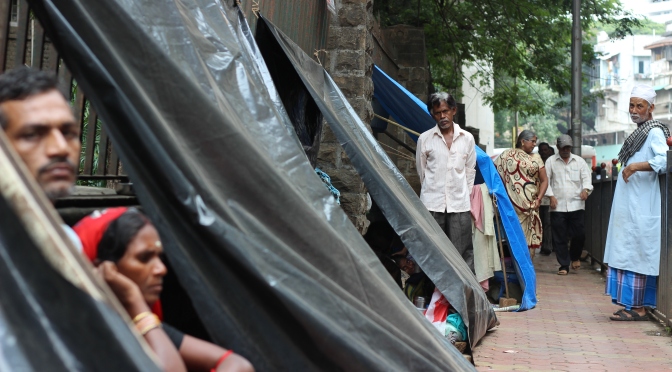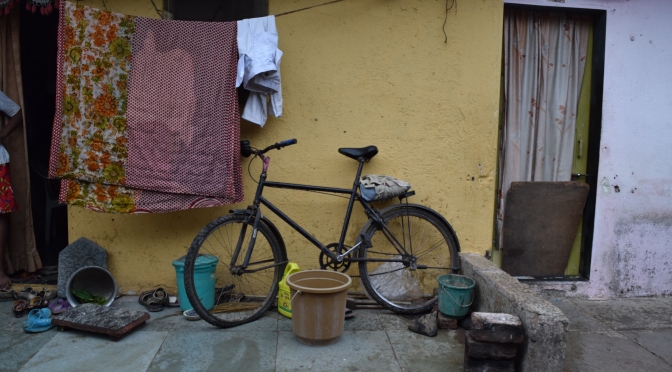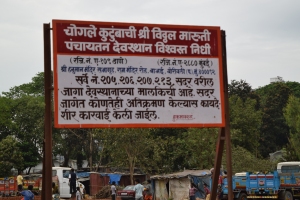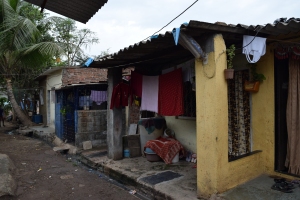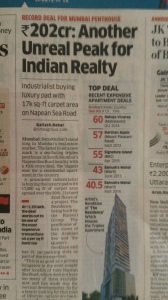Every day hundreds of patients make their way to Mumbai’s Tata Memorial Hospital, the nation’s premier cancer treatment facility. An acute shortage of hospital beds and lack of funds forces many patients and their families to live on the streets around the hospital during the course of their treatment. This is their story.
Text and Photos by Tanvi Khemani
It has been nine months, but Shiv Shankar Yadav vividly remembers the day he and his starry-eyed wife Savita Devi first landed in Mumbai, hoping to get her cured of cancer. An acquaintance of his had described the sprawling Tata Memorial Hospital (TMH) as a complex spread over seven floors and surrounded by swanky offices and high-rises in Parel. But Shiv Shankar, an acutely poor daily wage-worker who used to earn only Rs. 100 per day in his village in Bihar, made sure he brought along a panni (a thin black colored plastic sheet) and a mattress. He knew that they would have to live on the pavement outside the hospital while she received treatment there. Just like hundreds of other patients and their families belonging to the low-income group Shiv Shankar and his wife migrated to Mumbai, the city that never sleeps – only to sleep on its pavements.
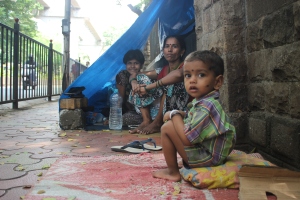
The hospital is part of the Tata Memorial Centre, a comprehensive centre for the prevention, treatment, education and research in cancer. It is estimated that 70% of the patients at the TMH are from the low-income group and most of them are migrants into Mumbai. The hospital’s Handbook for Patients states that the two categories of patients from the low-income group are the Not Charged (NC) patients who only pay for their medicines and the Charged patients who have to pay for their consultation and investigations as well. However, the 576 beds in the hospital are not enough for all. A volunteer working with a non-profit organisation in the area, who did not wish to be named, estimated that there are currently 400-500 patients living on the pavements outside the hospital. She claimed that the number of poor migrant patients to TMH has increased sharply in the last ten years. This is partly due to the shortage of adequate medical facilities in the country, especially in states like Uttar Pradesh and Bihar.
No attempt has been made by the medical fraternity, social sector or government to tackle the housing problem of these patients. The patients and their families occupy half the pavement across the hospital in a seemingly endless row of makeshift tents. One can see their clothes drying on the railings and feet protruding from under lots of ‘pannis’ (plastic sheets used as roofs). Even though they live on the streets, they try and keep their dwellings clean. “I sweep the floor thrice a day and we dispose of garbage in plastic bags. This pavement and panni is going to be our home until the treatment is complete,” says Sunaina Devi, wife and caregiver of Anandi Shah, a patient from Bihar. She has tied their tent to the railing of the pavement on one side and has secured the other side using some bricks she found nearby. She stores drinking water, spices for cooking, and utensils in small cardboard boxes inside her makeshift home. She said, “We brought clothes, a lota (glass) and a stool when we came from our village and begged for other things here. The mat we are sitting on is on loan from another patient who has gone home.”
The hospital authorities claim that TMH allows these patients to fill drinking water and to use the toilets on the hospital premises to help them stay clear of infections. But many of them have to use the ‘Sulabh Sauchalaya’ and drink tap water found nearby. The toughest time of the year for them is the monsoon, when the panni proves powerless against the constant rain and their mattresses get soaked.
Volunteers manning the NGO desk inside TMH said that there are some free dharamshalas such as Gadge Maharaj Dharamshala in Dadar, which charges Rs. 50 per day and also provides meals. Anandi Shah had tried his luck there first. “At the Dharamshala they told us that we would have to stay on their open ground under a panni till our turn for a bed came so we decided that if we had to live under a panni anyway, we’d rather live near TMH,” he said.
According to information in the ‘GLOBCAN Project 2012’ report published by the International Agency for Research on Cancer (IARC) under the World Health Organization (WHO), there were over 1 million people living with cancer in India in 2012. In contrast to the survival rate of 50% for cancer patients in more developed countries, patients in less developed countries like India have an abysmal survival rate of 33%. To match the standards of care for patients set by the WHO, India will have to add 1.7 million hospital beds and double its medical manpower, given its current population.
There is a need to reform the health sector itself. Dr Nitin S, an MD in Clinical Pharmacology at Sion Hospital said, “The hospital may provide subsidized medicines and radiotherapy or chemotherapy for the patients, but this is not enough. Factors such as diet, hygiene, exercise and counseling are equally important in the treatment of cancer.” He added that interventions aimed at decreasing the loneliness and isolation of migrant patients are needed to supplement their treatment.
Shiv Shankar is the sole earning member in his family of ten people. He had saved Rs. 60,000 from majdoori (daily wage labour) over many years, which has already been spent on his wife’s treatment. Like many other patients, he has borrowed extra money for the treatment at a very high rate of interest.
TMH has made arrangements for free meals for these patients on its premises. However, there is a catch: some medical officials at the hospital believe that this food is not sufficiently nutritious for the patients, and they urge them to eat homemade food instead. Savita Devi said, “The doctor told us that I should not eat the food distributed by the Sai Trust as my chemotherapy treatment has made me very weak.”
The hospital authorities claim that TMH allows these patients to fill drinking water and to use the toilets on the hospital premises to help them stay clear of infections. But many of them have to use the ‘Sulabh Sauchalaya’ and drink tap water found nearby. The toughest time of the year for them is the monsoon, when the panni proves powerless against the constant rain and their mattresses get soaked. Living on the pavement renders them especially vulnerable to contagious diseases like influenza, malaria and dengue at this time. Shiv Shankar recalls, “During the monsoon we sat in knee-high water all night, on this pavement.” The mosquitoes are another menace.
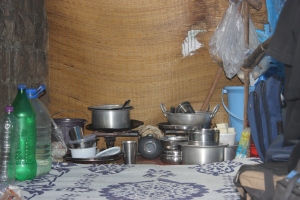
Shiv Shankar is the sole earning member in his family of ten people. He had saved Rs. 60,000 from majdoori (daily wage labour) over many years, which has already been spent on his wife’s treatment. Like many other patients, he has borrowed extra money for the treatment at a very high rate of interest. “How can my uncle, who was a daily laborer, pay Rs 2.5 lakhs for his surgery which the hospital is quoting?” wonders Shabir Ahmad, a young mechanic who has accompanied his uncle Kallu mian to a session of chemotherapy.
Bangali Yadav, a 50-year old thoracic cancer patient from Bihar, sits with Shiv Shankar and they watch the traffic thunder past them as reminisce about their villages. They miss their children and hope to bring them to Mumbai one day to see this majestic city. Bangali says, “I had never even dreamed that we would come to Bombay sheher (city) in this lifetime.” Anandi’s love for the city is palpable as he says, “I have roamed many cities, but this is the best city. We are able to survive because of the generosity of big companies and hotels. This doesn’t happen anywhere else.”
“They are very brave”, said Bhano Subramaniam, a social worker who has been working with the patients for over a decade. Chandra, her colleague at the Social Welfare desk in TMH, marvels at the indomitable spirit of these patients. She says, “We’ve seen some patients come, stay on the pavement for months, eat paav bhaji and whatever else they can find, and go home fully cured.”
You Can Get Help Here
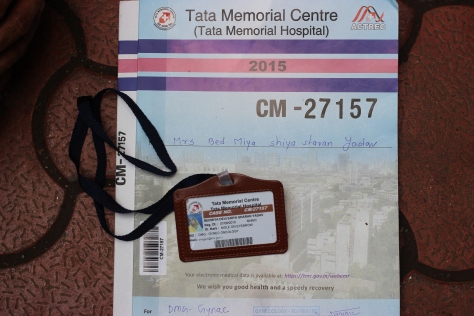
1. Helpline for patients at TMH: +91 2224177099/ 2224177000
2. Medical Social Workers Dept. of TMH https://tmc.gov.in/medical/departments/as/as.htm
3. Indian Cancer Centre (Parel): 022 2413 9445
4. V Care Foundation helpline: +9198219 49401/02 toll free 18002091101
5. Dr Ernest Borges Memorial Home in Bandra (accommodation through TMH): 02226591404
6. St. Judes Centre for Children (accommodation for children): 022 2417 1614
Cover picture: A row of temporary housing structures set up by outstation patients directly across the road from Tata Memorial Hospital.

